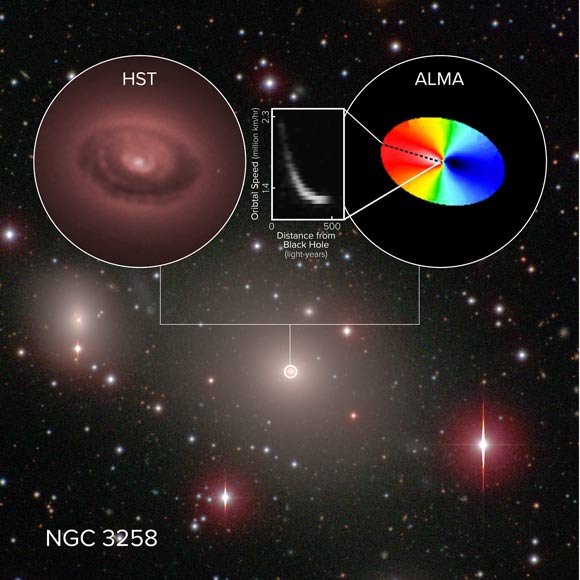ALMA Determines Mass of Supermassive Black Hole in NGC 3258 | Astronomy – Sci-News.com
Astronomers using the Atacama Large Millimeter/submillimeter Array (ALMA) have observed the dynamical sphere of influence of a supermassive black hole located at the center of NGC 3258, a giant elliptical galaxy about 100 million light-years from Earth, and determined that this black hole weighs a staggering 2.25 billion solar masses.

ALMA made the most precise measurements of cold gas swirling around a supermassive black hole — the cosmic behemoth at the center of the giant elliptical galaxy NGC 3258. The multi-color ellipse reflects the motion of the gas orbiting the black hole, with blue indicating motion toward us and red motion away from us. The inset box represents how the orbital velocity changes with distance from the black hole. The material was found to rotate faster the closer in the astronomers observed to the black hole, enabling them to accurately calculate its mass: a whopping 2.25 billion times the mass of our Sun. Image credit: ALMA / ESO / NAOJ / NRAO / B. Boizelle / AUI / NSF / S. Dagnello / Hubble Space Telescope / NASA / ESA / Carnegie-Irvine Galaxy Survey.
Astronomers use a variety of methods to measure black hole masses.
In giant elliptical galaxies, most measurements come from observations of the orbital motion of stars around the black hole, taken in visible or infrared light.
Another technique, using naturally occurring water masers in gas clouds orbiting around black holes, provides higher precision, but these masers are very rare and are associated almost exclusively with spiral galaxies having smaller black holes.
The ALMA team recently pioneered a new method to study black holes in giant elliptical galaxies.
About 10% of elliptical galaxies contain regularly rotating disks of cold, dense gas at their centers. These disks contain carbon monoxide gas, which can be observed with millimeter-wavelength radio telescopes.
By using the Doppler shift of the emission from molecules of carbon monoxide, astronomers can measure the velocities of orbiting gas clouds, and ALMA makes it possible to resolve the very centers of galaxies where the orbital speeds are highest.
“We’ve been surveying nearby elliptical galaxies with ALMA for several years to find and study disks of molecular gas rotating around giant black holes,” said Professor Aaron Barth, an astronomer with the University of California, Irvine.
“NGC 3258 is the best target we’ve found, because we’re able to trace the disk’s rotation closer to the black hole than in any other galaxy.”
The inner regions of NGC 3258’s disk orbit faster than the outer parts due to the black hole’s gravity.
The ALMA data show that the disk’s rotation speed rises from 620,000 mph (1 million kmh) at its outer edge, about 500 light-years from the black hole, to well over 1.9 million mph (3 million kmh) near the disk’s center at a distance of just 65 light-years from the black hole.
The astronomers determined the black hole’s mass by modeling the disk’s rotation, accounting for the additional mass of the stars in the galaxy’s central region and other details such as the slightly warped shape of the gaseous disk.
The clear detection of rapid rotation enabled the researchers to determine the black hole’s mass with a precision better than one percent, although they estimate an additional systematic 12% uncertainty in the measurement because the distance to NGC 3258 is not known very precisely.
Even accounting for the uncertain distance, this is one of the most highly precise mass measurements for any black hole outside of the Milky Way Galaxy.
A paper describing the findings was published in the Astrophysical Journal (arXiv.org preprint).
_____
Benjamin D. Boizelle et al. 2019. A Precision Measurement of the Mass of the Black Hole in NGC 3258 from High-resolution ALMA Observations of Its Circumnuclear Disk. ApJ 881, 10; doi: 10.3847/1538-4357/ab2a0a





